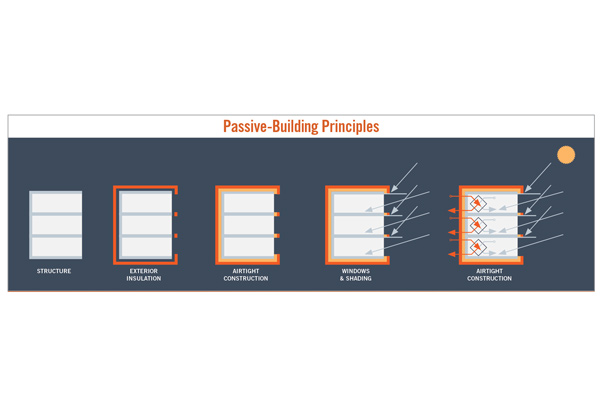Today's Steps for Tomorrow's Net Zero

Passive-building strategies can get new construction to net zero energy consumption.
According to the U.S. Energy Information Agency, commercial and residential buildings accounted for 29% of total U.S. energy consumption in 2020. With the growing emphasis on climate change, many national, state and local jurisdictions have set ambitious goals to decrease carbon emissions.
One such goal, upheld by initiatives such as the Paris Climate Agreement, is to get to net zero carbon emissions across the building industry. Net zero carbon emissions means the building consumes the least amount of energy possible while also producing enough energy from sustainable sources to compensate for the energy it actually uses.
Reducing a building’s carbon emissions is most easily done by managing its heating and cooling to achieve net zero energy consumption. Passive-building construction and certification (also called passive-house construction) is specifically designed to drastically reduce energy usage and help buildings reach net zero energy consumption.
Born in Europe
Passive-building principles were originally developed in Europe in the 1980s to enhance the energy efficiency of single-family homes. After decades of experimentation and improved modeling tools, the principles are now being applied to larger commercial buildings due to the economies of scale.
According to the Passive House Institute US (PHIUS), there are nearly 200 PHIUS-certified and pre-certified commercial and multifamily projects either finished, under construction or in the planning stages in the U.S.

Passive-building structures feature continuous insulation across the envelope, high-performance windows and strong ventilation. Source: Tiscareno Associates
A large passive-building structure can achieve certification more easily than a smaller one. This seems counterintuitive, but it explains why passive building can scale up to commercial construction. The smaller surface-to-volume ratio of larger buildings makes insulating the space more cost-efficient, and the larger number of people occupying the building can actually serve as space heaters. This can add up in office, commercial and industrial applications.
Certification for passive-building structures is performance-based — granted only after a building has operated for a year and proven its ability to heat and cool with net zero energy use. However, passive-building design does not have to be an all-or-nothing proposition. These strategies can be immediately applied to significantly reduce energy consumption.
Net Zero and Passive Building
Net zero energy consumption focuses on designing buildings to minimize the amount of energy they require each year from the grid and replace the energy they do use by producing equivalent energy from sustainable sources, such as solar panels.
For instance, if a building requires an average of half a million kilowatt hours of electricity a year to run, it would need enough solar panels installed to return half a million kilowatts to the grid that same year — a net of zero energy used. Obviously, the more energy-efficient the building, the less energy needs to come from the grid, and the fewer solar panels are needed to compensate for the amount consumed.
And that is where passive-building strategies are helpful. This approach rigorously applies five building-science principles to make buildings more energy efficient and less costly in dollars and resources to heat and cool throughout their lifecycle:
- Continuous insulation throughout the entire envelope to mitigate thermal bridges, or places where heat can easily move from the interior to the exterior.
- An airtight envelope, preventing infiltration of outside air and loss of conditioned air.
- High-performance (double- or triple-paned) windows, along with shades, to exploit the sun’s energy for heating in colder seasons and minimize overheating in warmer seasons.
- Heat and moisture-recovery fresh air ventilation.
- Minimal space conditioning systems.
Pluses, Minuses of Passive-Building Strategies
According to PHIUS, the initial costs of passive-building strategies are, on average, 5% to 10% higher than those of traditional construction. However, they can yield potential energy savings of more than 90% year after year. This can outweigh the short-term financial gains of designing a project solely to reduce construction costs, which often leads to much higher energy bills over time.
Beyond energy efficiency, passive-building construction can deliver other benefits such as:
Durability. A building’s inherent airtightness prevents air and water infiltration, avoiding humidity and helping materials last longer.
High air quality. Continuous mechanical ventilation of fresh filtered air provides superb indoor air quality, which is especially important when external air quality is poor because of pollution.
Occupant comfort. Superinsulation and airtight construction provide unmatched comfort.
While passive-building construction has many upsides, there are some important caveats to keep in mind as well. For instance, while there are some retrofit projects that use passive-building techniques, the best results are generally achieved with new construction. Additionally, passive-building construction costs can be significantly higher in areas with extreme temperatures.
Things to Consider
Passive-building strategies must be integrated into the project from the beginning. Energy modeling is required at various stages to calculate the expected energy consumption by month, season and year, and validate target reductions. Each design decision — from building orientation to window size and placement, to the amount of roof space allotted for solar panels — must be viewed in light of its effect on the project’s goals, budget and net zero objectives.
Successful implementation requires a team experienced in energy codes, sustainability practices and materials selection. Just as a LEED consultant is needed for LEED certification, seek out a team that has a sustainability consultant who is familiar with passive-building strategies.
It is also important to work with an experienced contractor who has a good knowledge of the building envelope and can address thermal bridging and air tightness. Bringing the contractor in early to collaborate with the design team is critical to help the architect achieve cost-effective, energy-efficient solutions and avoid any constructability issues that could stall the project on site.
Plan for Net Zero
There are many viable technical pathways to deliver low-energy and net zero energy buildings for 2030 and beyond. As a construction standard designed to help minimize the load that renewable energy sources must provide during a building’s lifetime, passive building offers a clearly defined path to ultra-low energy performance using a proven technical approach.
Passive-building strategies can help achieve sustainability goals in all building types.
Rosa Folla has been an architect in Italy, Los Angeles and Seattle for more than 20 years, working on institutional, commercial and residential buildings with an emphasis on adaptive reuse. She is the former chair of AIA Seattle COTE, a Certified Passive House Consultant and a member of Passive House Institute US.



